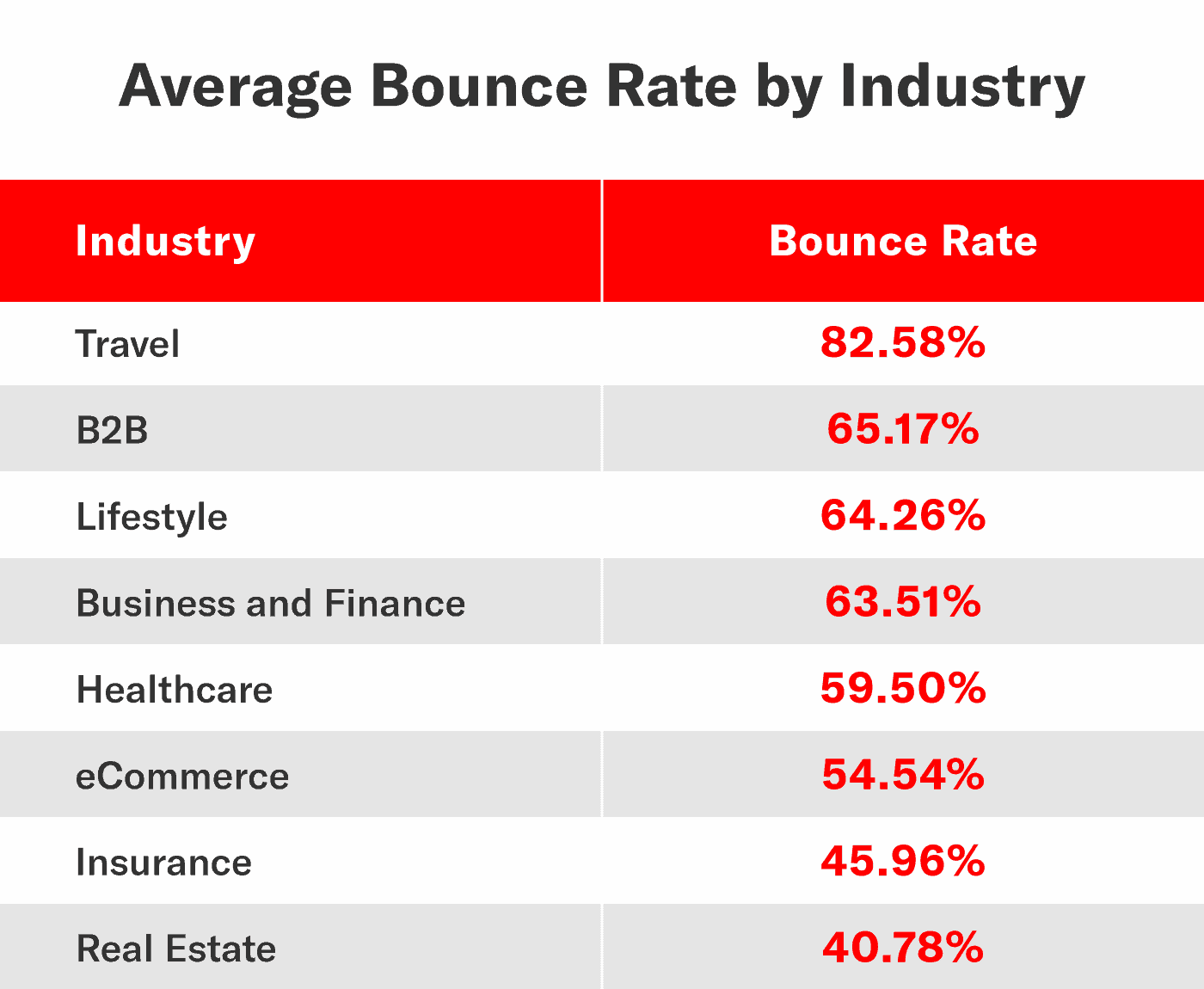According to our analysis of over a billion sessions, a good bounce rate is somewhere under or around 50%, although it depends on the industry. A good bounce rate for a blog is 70%, with the average being 80%.
If all of these numbers sound like another language to you, let’s start back at square one. What is this “bounce rate” thing, and even more importantly, what is a good bounce rate?
All web traffic is not created equal. Users are coming to your site for a number of different reasons and from a number of different sources. Not to mention various industries, target audiences and other aspects that influence bounces.
To write this article, we analyzed the anonymized data from some of our 110-person content marketing agency client’s Google Analytics accounts to get a broad overview of what a good bounce rate is. But first, let’s discuss what goes into the bounce rate calculation.
What is Bounce Rate?
Bounce rate is the percentage of sessions that do not navigate to any additional pages on the site. The formal definition of bounce says it all: “to move quickly back from a surface after hitting it.” In this case, your site is the surface and the user’s back button is the bounce.
Google defines a bounce as a single-page session. So the bounce rate formula Google Analytics uses is the number of single-page sessions divided by total sessions, or simply:
Bounces / Sessions = Bounce Rate
How We Measured Good Bounce Rates
Many other articles about what makes a good bounce rate only factor in one site, which renders their data anecdotal and not relevant to your business, blog or landing page. Even if their site receives respectable traffic, there is no statistical significance in looking at the performance of just one site.
In our study, we analyzed the Google Analytics data of 42 client websites over the last year, totaling more than 1.3 billion sessions.
Root Domain Bounce Rate
In content marketing, we mainly hang out in the blog or resource section of the site, but we figured it would be good to establish a baseline bounce rate.
In our study, we analyzed over a billion sessions from all traffic sources and more than 700 million bounces to calculate the average bounce rate of 50.9%.
It’s worth noting that some websites in our study had bounce rates as high as 92% and as low as 10%. The average bounce rate within the travel industry, for example, was 82.6%. The average bounce rate within the real estate industry, however, was 40.8%.
This massive variation in bounce rate is why it’s important to not rely on a single site or industry’s data.
Blog Bounce Rate
To dig deeper, we were able to confidently analyze 28 of our client’s blogs, specifically pages with “/blog/” in the URL path. With this segment in mind we were able to analyze more than 84 million blog sessions to calculate an average bounce rate for blog traffic:
9,546,646 bounces /
84,406,343 sessions
= 82.4% bounce rate
Regarding industry, we noticed eCommerce and lifestyle blogs had some of the highest bounce rates, some higher than 90%. On the other end of the spectrum, blogs in business, finance, insurance and real estate space had lower bounce rates on average.
What is a Good Bounce Rate?
You might be surprised to see that some of the most iconic and popular companies on the web today are experiencing bounce rates upwards of between 50% and 80%+ and perhaps you are seeing the same figures on your site. Depending on your industry, website and other factors, this could be what you can realistically expect as a good bounce rate.
The absolute lowest bounce rate in our study was 10.04%.
Below is a chart of the average bounce rate by industry:
Optimizing your bounce rate is nonetheless important because no matter what business or industry you create content for, you want people to actually engage with that content.
We believe if you can get your sitewide bounces below 50% of total sessions, you will have achieved a good bounce rate. But if your bounce rate is closer to 80%, this doesn’t mean you can’t have a successful business or blog, this just means you need to optimize your site to drive more sessions.
Is a High Bounce Rate Always Bad?
No, in some situations a high bounce rate can be a positive signal.
For example, if you landed on this article simply looking for a quick answer to the question above, you just got it and you might head for the back button without sticking around to learn why. This means that our blog post did well to answer your question – which is what Google wants.
If the page is informative and gets to the root of what the user wants to know, such as contact pages, pricing, menus, services and more, the user could bounce with intentions of taking the conversation and ultimate conversion to another channel.
If instead you came for a confessional to ask the Google Gods for the forgiveness of your bounce rate, you might stick around and learn how to improve it.
How to Improve Bounce Rate
The following strategies are what we believe will help decrease your bounce rate, drive more engagement across your site and increase brand awareness and brand affinity.
1. Create Relevant Content
We’ve discussed this topic before in regards to link relevancy, but for bounce rate, you’ll also want to establish a cohesive content strategy that remains consistent and relevant to your audience.
If your site is focused on real estate, you shouldn’t be creating content about the latest celebrity scandal – it simply isn’t relevant. The probability that someone who comes to your site to keep up with the Kardashians will also want to read about the difference between fixed and adjustable rates is extremely low.
Instead, you can focus on creating a cohesive guide that goes in-depth on fixed mortgage rates which will keep your target audience engaged, and then you can hit them with a piece on adjustable mortgage rates, a logical next step in their real estate journey.
2. Optimize Pagespeed
It’s pretty clear you’ve been on the internet before (unless you got my handwritten version of this post in the mail) and chances are you’ve contributed to one of the many statistics that nearly everyone exits a site if it takes longer than 3-seconds to load.
Use the tools provided by Google such as PageSpeed Insights and Lighthouse Audits to test that your site is meeting the performance, accessibility, best practices and SEO standards. Some of the most common things we’ve seen improve loading speed is:
- Use of a content delivery network (CDN)
- Minification of HTML, CSS and Javascript
- Removal of unused code
3. Suggest Related Content
Having popular, related, recent or other curated content suggestions on the page will help engage and incentivize users to remain on your site, therefore decreasing your bounce rate.
These relevant content suggestions could come in the form of a sidebar, inline or beneath the current post. I’ll willingly run the risk of sounding repetitive to emphasize my point here but the keyword again here is relevant. Simply suggesting another article at random might work every now and then, but suggesting the obvious next rung in the metaphorical ladder is essential.
4. Utilize Internal Linking
For a long time now, we’ve been placing a greater emphasis on the power internal linking can bring for our clients. Internal links can help signal your sites informational hierarchy to search engine bots and establish topic clusters.
I’ll say it once more (in this post), your internal links must be relevant to the topic at hand. You may have not even noticed a few internal links within this very post (five to be exact) because they were silky smooth and relevant.
What if in an effort to sneak one more internal link in, I linked to a post about building reporter relationships (gotcha, that’s not a real link), even if all your outreach emails are bouncing, there would be zero connection with our post on web traffic bounce rate.
Monitoring the Good, the Bad and the Bounce Rate
We will always and forever advocate that you continue to measure and monitor performance to see what is working. Consider running a 4-month long test implementing the above strategies and measuring how each impact your bounce rate.
If you are self-confident in the size of your bounce rate, you likely understand the importance of and reliance on other important metrics, like conversion rate. If your source of traffic is primarily through paid ads, you should be more tolerant of a higher bounce rate compared to organic traffic.






